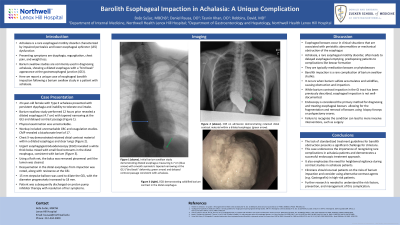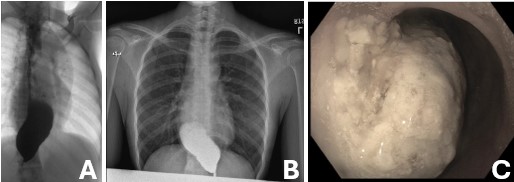Tuesday Poster Session
Category: Esophagus
P3996 - Barolith Esophageal Impaction in Achalasia: A Unique Complication
Tuesday, October 29, 2024
10:30 AM - 4:00 PM ET
Location: Exhibit Hall E

Has Audio
- BS
Boze Susac, MBChB
Lenox Hill Hospital, Northwell Health
New York, NY
Presenting Author(s)
Boze Susac, MBChB, Daniel Rausa, DO, Tasnin Khan, DO, David Robbins, MD
Lenox Hill Hospital, Northwell Health, New York, NY
Introduction: Achalasia is a rare esophageal motility disorder characterized by impaired peristalsis and lower esophageal sphincter (LES) dysfunction, presenting with dysphagia, regurgitation, chest pain, and weight loss. Barium swallow studies are commonly used in diagnosing achalasia, showing a dilated esophagus with a "bird beak" appearance at the gastroesophageal junction (GEJ). Here we report a unique case of esophageal barolith impaction following a barium swallow study in a patient with achalasia.
Case Description/Methods: A 23-year-old female with Type II achalasia presented with persistent dysphagia and inability to tolerate oral intake. A barium swallow study performed 12 hours prior revealed a dilated esophagus (4.7 cm) with tapered narrowing at the GEJ and delayed contrast passage (Figure A). Physical examination was unremarkable. Workup included unremarkable CBC and coagulation studies. CMP revealed a bicarbonate level of 17. Chest X-ray (CXR) demonstrated retained distal contrast material within a dilated esophagus and clear lungs (Figure B).
An urgent esophagogastroduodenoscopy (EGD) revealed a white thick bolus mixed with small food remnants in the distal esophagus, consistent with barium (Figure C). Using a Roth net, the bolus was removed piecemeal until the lumen was cleared. Desquamation in the distal esophagus from impaction was noted, along with resistance at the GEJ. A 15 mm stepwise balloon was used to dilate the GEJ, with the diameter progressively increased to 18 mm. The patient was subsequently discharged on proton pump inhibitor therapy with resolution of her symptoms.
Discussion: Barolith impaction is a rare complication of barium swallow studies. This occurs when barium sulfate accumulates and solidifies, causing obstruction and impaction. While barium contrast impaction in the GI tract has been previously described, esophageal impaction is not well-documented. This case underscores the importance of recognizing rare complications in patients with achalasia and demonstrates a successful endoscopic treatment approach. Clinicians should counsel patients on the risks of barium impaction and consider using alternative contrast agents (e.g. Gastrografin) in high-risk patients. Further research is needed to understand the risk factors, prevention, and management of this complication.

Disclosures:
Boze Susac, MBChB, Daniel Rausa, DO, Tasnin Khan, DO, David Robbins, MD. P3996 - Barolith Esophageal Impaction in Achalasia: A Unique Complication, ACG 2024 Annual Scientific Meeting Abstracts. Philadelphia, PA: American College of Gastroenterology.
Lenox Hill Hospital, Northwell Health, New York, NY
Introduction: Achalasia is a rare esophageal motility disorder characterized by impaired peristalsis and lower esophageal sphincter (LES) dysfunction, presenting with dysphagia, regurgitation, chest pain, and weight loss. Barium swallow studies are commonly used in diagnosing achalasia, showing a dilated esophagus with a "bird beak" appearance at the gastroesophageal junction (GEJ). Here we report a unique case of esophageal barolith impaction following a barium swallow study in a patient with achalasia.
Case Description/Methods: A 23-year-old female with Type II achalasia presented with persistent dysphagia and inability to tolerate oral intake. A barium swallow study performed 12 hours prior revealed a dilated esophagus (4.7 cm) with tapered narrowing at the GEJ and delayed contrast passage (Figure A). Physical examination was unremarkable. Workup included unremarkable CBC and coagulation studies. CMP revealed a bicarbonate level of 17. Chest X-ray (CXR) demonstrated retained distal contrast material within a dilated esophagus and clear lungs (Figure B).
An urgent esophagogastroduodenoscopy (EGD) revealed a white thick bolus mixed with small food remnants in the distal esophagus, consistent with barium (Figure C). Using a Roth net, the bolus was removed piecemeal until the lumen was cleared. Desquamation in the distal esophagus from impaction was noted, along with resistance at the GEJ. A 15 mm stepwise balloon was used to dilate the GEJ, with the diameter progressively increased to 18 mm. The patient was subsequently discharged on proton pump inhibitor therapy with resolution of her symptoms.
Discussion: Barolith impaction is a rare complication of barium swallow studies. This occurs when barium sulfate accumulates and solidifies, causing obstruction and impaction. While barium contrast impaction in the GI tract has been previously described, esophageal impaction is not well-documented. This case underscores the importance of recognizing rare complications in patients with achalasia and demonstrates a successful endoscopic treatment approach. Clinicians should counsel patients on the risks of barium impaction and consider using alternative contrast agents (e.g. Gastrografin) in high-risk patients. Further research is needed to understand the risk factors, prevention, and management of this complication.

Figure: A. Initial barium swallow study demonstrating “bird beak” esophageal appearance. B. CXR on admission demonstrating retained contrast material in the distal esophagus and C. EGD demonstrating solidified barium contrast in the distal esophagus.
Disclosures:
Boze Susac indicated no relevant financial relationships.
Daniel Rausa indicated no relevant financial relationships.
Tasnin Khan indicated no relevant financial relationships.
David Robbins indicated no relevant financial relationships.
Boze Susac, MBChB, Daniel Rausa, DO, Tasnin Khan, DO, David Robbins, MD. P3996 - Barolith Esophageal Impaction in Achalasia: A Unique Complication, ACG 2024 Annual Scientific Meeting Abstracts. Philadelphia, PA: American College of Gastroenterology.
